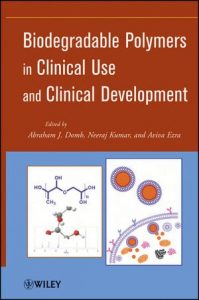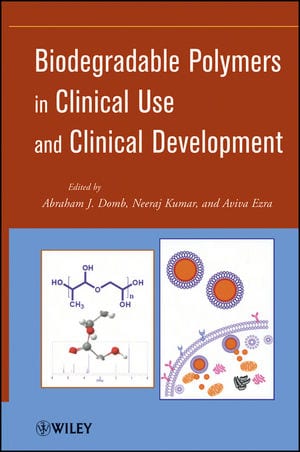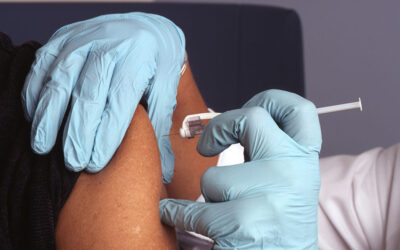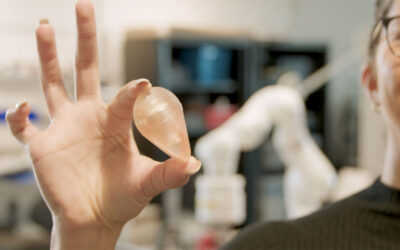 Biodegradable Polymers in Clinical Use and Clinical Development
Biodegradable Polymers in Clinical Use and Clinical Development
Editors: Abraham J. Domb and Neeraj Kumar
Hardcover
752 pages
US $149.95
In recent years, there has been a steadily growing interest in the development of biodegradable materials for application in medicine and biotechnology. The main task of biomedical research is to create a biomaterial with physical and chemical properties that most closely match those required for a particular medical application. For clinical use, the degradable materials must meet specific criteria in terms of their biocompatibility. In addition to the potential problem of toxic contaminants leaching from the material (for example, residues of chemicals used in the material synthesis), one must also consider the potential toxicity of the degradation products and subsequent matabolites.
Many types of polymers (natural and synthetic) are widely used in biomedicine, including dental, orthopaedic, ophthalmologic, soft tissue, and cardiovascular implants, drug delivery and controlled drug release at the place of interest. The book Biodegradable Polymers in Clinical Use and Clinical Development, edited by Abraham J. Domb, Neeraj Kumar, and Aviva Ezra, consists of eighteen chapters covering descriptions of various natural and synthetic polymers mainly focusing on their synthesis, properties, and application in different biomedical fields.
In Chapter 1 Jay Prakash Jain, Wubeante Yenet Ayen, Abraham J. Domb , and Neeraj Kumar gave an excellent brief overview of different classes of biodegradable polymers with more than 350 literature references. The main accent is on the properties of polymers, major clinical applications, and names of marketed products. In addition, the biodegradation patterns and polymer selection for biomedical application in order to meet specific end-use requirements are discussed. Several commercially available formulations for controlled release that are based on biodegradable polymers are shown.
In the following Chapters 2 and 3, the molecule structure, synthesis, properties and application of collagen and gelatine are presented. Collagen has a unique ability to form insoluble fibers that provide strength. It plays an important role in the creation of skin, muscle, bone and cartilage. Collagen-based biomaterials have been widely used for a number of tissue engineering and medical applications. Several examples of application and commercially available products are given in the chapter: i) collagen injections/dermal fillers (for the correction of moderate to severe wrinkles); ii) matrix collagen sponges (for wound healing/repair, reparation of bone defects, etc.); iii) carriers for controlled drug delivery/release (in the form of hard minipellets/tablets or soft gels). Gelatine is a protein-based natural polymer, produced by partial hydrolysis of collagen. It is categorized as a physical gel and has been widely used as absorbable hemostatic agents for hemostatsis.
Chapters 4, 5, 6, and 7 highlight the role of naturally occurring polysaccharides such as chitosan, alginate, dextrane/pentosan, and arabinogalactan in clinical use. Research from India and Israel gave very informative overview of the properties, modifications and applications of the polysaccharide based derivates in e.g., cardiology, neurology, and as a carrier for drug and gene delivery.
Chapter 8 discusses the biosynthesis, properties/characterization and application of polyhydroxyalkonates (PHAs). PHAs represent example of bioresorbable polyesters that are produced by various microorganisms. The mechanical properties, biocompatibility and rate of degradation can be controlled by changing the composition of PHA polymers. At the end of the chapter, a list of recent patents on PHA application in medical field is presented.
The following Chapters 9, 10, 11, 12, and 13 introduce readers to the synthetic biodegradable polymers. The synthesis, properties and application (mainly as a drug delivery formulations) of lactides and glycolides based polymers are described in Chapter 9. Polylactides (PLLA) and polyglycolides (PLGA) and their copolymers, for example poly(ε-caprolactone-co-glycolide) (Chapter 11) are currently the most widely investigated, and most commonly used synthetic, bioerodile polymers. The authors gave a brief description of different techniques that could be used for characterization of PLLA and PLGA polymers.
Polyanhydrides (Chapter 10), due to their fast / uniform degradation and limited mechanical properties, are widely applied in medicine as short-term controlled delivery of bioactive compounds.
Development and application of cyanoacrylates as bioadhesives and as drug nanocarriers are discussed in Chapter 12. Results of different in vitro and in vivo tests performed with cyanoacrylate nanoparticles that had various medical “payloads” and surface coatings (e.g. PEG, polysorbate 80, etc.), are presented.
Chapter 13 focuses on one of the most frequently used polymers in biomedicine, i.e. polyethylene glycol (PEG), with an emphasis on the chemistry of PEGylation and formulation of PEGylated drugs. The authors gave a brief summary of the marketed PEGylated drugs, including the brand name, type of PEG conjugate, name of company, type of PEGylation, clinical application, dosing information, and year of approval.
Inorganic polymers such as calcium phosphates have been widely used as implant or coating material for bone replacement/repair, or regeneration. The synthesis, properties (crystallinity, chemical composition, biodegradability, toxicity, etc.) and clinical use of the calcium phosphate ceramics in vivo and in vitro are reviewed in Chapter 14.
In Chapter 15 Jeff Sparks and Khursheed Anwer from the biopharmaceutical company EGEN (Huntsville, Alabama, USA) give a brief overview of biocompatible polymers that are used for delivery of therapeutic genes, siRNA and small molecules. The chapter is divided into four sections, which cover the formulation of drug carriers from cationic polymers (polyethyleneimine, cationic polyesters, synthetic polypeptides, polysaccharides etc.) and synthetic noncondencing polymers, polymeric systems used for siRNA delivery, and clinical development of polymer-based delivery systems for cancer, HIV-AIDS and cardiovascular disease treatments.
The role and major clinical applications of biodegradable polymers in tissue engineering are discussed in Chapter 16. The authors presented different approaches of tissue engineering as well as the strategies for use of biodegradable polymers in tissue engineering.
Chapter 17 focuses on the development and medical applications of injectable polymers. The major chemistries that are involved in the formulation of in situ forming materials together with the design considerations are presented. The clinical use of natural and synthetic polymers in drug delivery and tissue engineering are reviewed.
At the end of the book (Chapter 18), an extended review on patents, innovations and technological challenges of biodegradable polymers that are used in drug delivery and ti
ssue engineering is presented. This chapter provides very useful technical information for researches who are working in the area of synthesis and development of biodegradable polymers for medical applications.

















